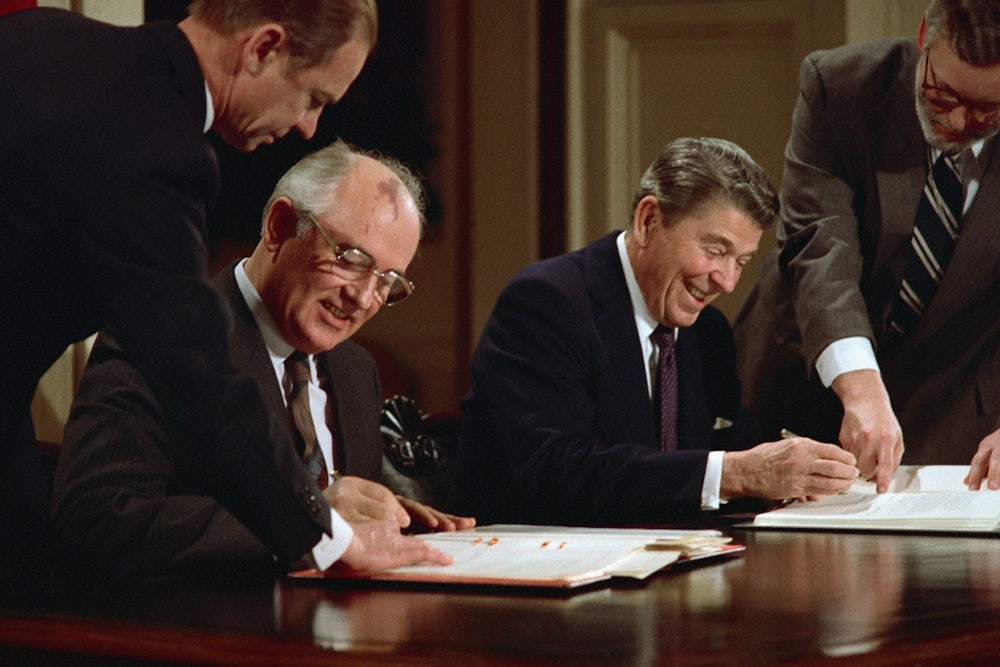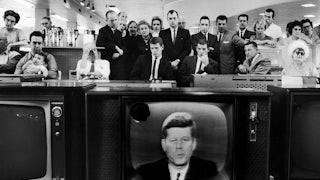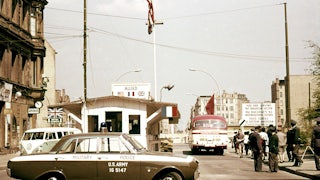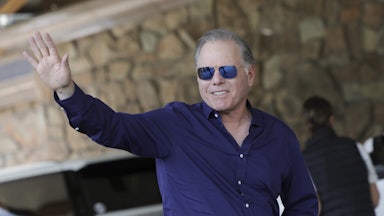Nearly two decades after his death—and more than 30 years after his presidency—Ronald Reagan still plays a prominent role in the pageant of American politics: He is the hallowed cipher for a “strong” foreign policy. Politicians can invoke the fortieth president’s name to grant an imprimatur of “greatness” to current policy positions, even if they carry only a tenuous connection to the views of the man himself. Though Donald Trump’s ascendancy may have somewhat diminished Reagan’s hold on the Republican Party, any “strong on defense” politician worth their salt knows: When in doubt, you bring out the Gipper.
In March, for example, Senator Lindsey Graham suggested to Sean Hannity that Reagan would have happily risked World War III in response to a collision between a Russian jet and a U.S. drone over the Black Sea: “He would start shooting Russian planes down.” Anyone with even a passing knowledge of the Reagan administration will recognize this as, at best, a cartoonish depiction of its approach to foreign affairs. Yet it relies on a widely made argument: that Reagan’s tough defense policies, his insistence on “peace through strength,” brought an end to the Cold War, “winning” the long, twilight struggle against the Soviet Union for the United States.
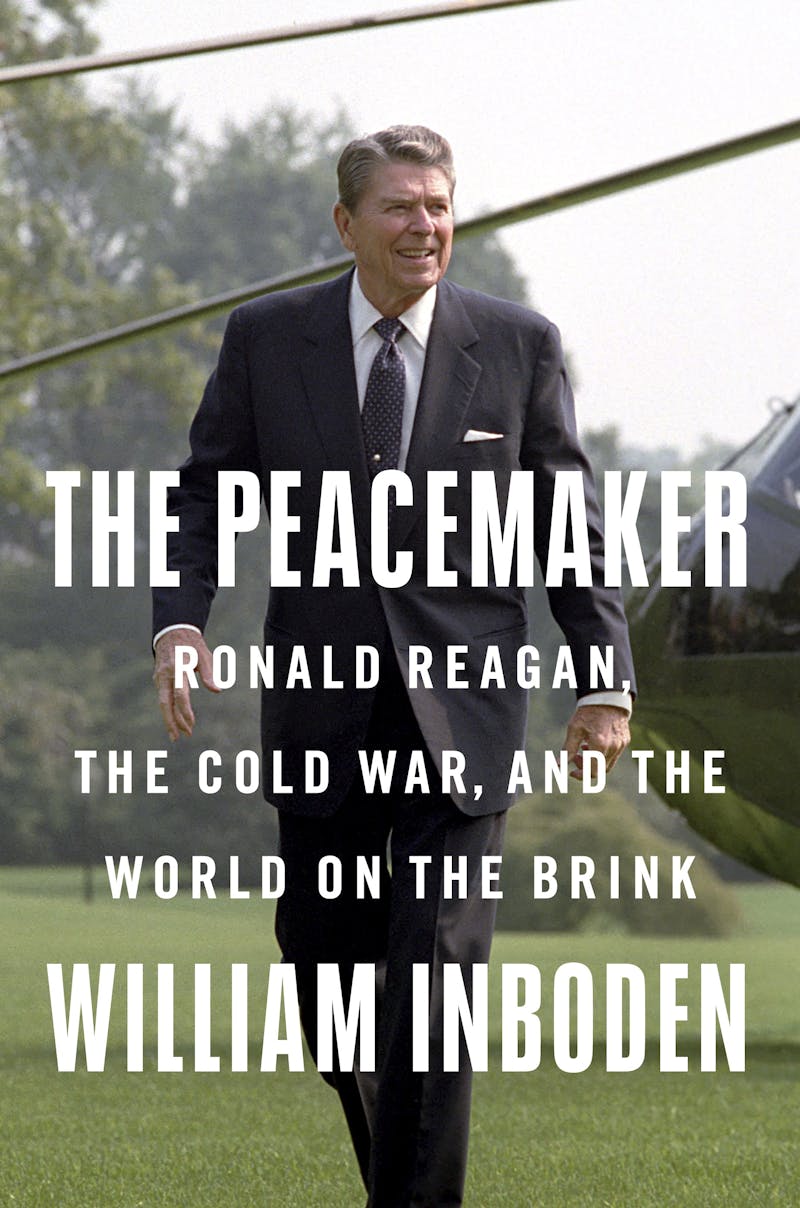
It is this argument that William Inboden makes in his book The Peacemaker: Ronald Reagan, the Cold War, and the World on the Brink, an analysis of Reagan’s role in the final decade of the Cold War. Infinitely more sophisticated than Graham’s grandstanding, Inboden’s book is also far more likely to influence serious discussions of foreign policy behind closed doors. Former Senator Ben Sasse suggests in a blurb that “as Americans stare down the possibility of a Beijing-led twenty first century,” they “would do well to learn from” Inboden’s Ronald Reagan. Many no doubt will, as The Peacemaker is the standout example of its genre.
The only problem is that, in doing so, they will learn many of the wrong lessons. Reagan’s significant and salutary role in ending the Cold War cannot be denied, but he was a far different sort of “peacemaker” than Inboden suggests.
Though the memory has faded with time, the peaceful end of the Cold War was experienced by those who lived through it as nothing short of a miracle. Somewhere between Ronald Reagan’s presidential visit to Moscow in 1988 and the final dissolution of the Soviet Union in December 1991, the two “superpowers” began to release each other from the death grips they had held for decades. Since at least the development of intercontinental ballistic missiles and thermonuclear weapons in the 1950s, the two powers had plausibly threatened the annihilation of humanity. The dread of a dark, nuclear-scarred future hovered just out of mind for all, whether in the “East” or the “West.” Thus the largely nonviolent collapse of the Soviet empire was a startling transformation, made all the more so by the fact that in the late 1970s, the Soviet Union had been widely perceived as winning the Cold War against a declining United States (“The world”, as one Soviet official later put it, “was going our way”).
Debate on how humanity had dodged this nuclear bullet began almost immediately after the Soviet Union fell. Early takes tended to fall into one of two camps. On the one hand were those who gave most of the acclaim to the Soviet Union’s final leader, Mikhail Gorbachev. They credited his energy and passion—a departure from the sclerotic Soviet leaders of the 1970s—his desire to lower tensions with the United States, and, most critically, his push for glasnost (openness) and perestroika (restructuring) of the undemocratic and stultifying Soviet system.
On the other were those who pointed to the U.S. and Ronald Reagan. They believed that the collapse of Soviet power vindicated the “containment” policy the U.S. had implemented in the 1940s and ’50s to limit Soviet global influence. Reagan was credited with having revitalized that approach with his spectacular increases in defense spending, his expansion of covert action against Communist regimes, and his vigorous escalation of the war of words with the Soviet Union—labeling it, among other things, an “evil empire” destined for the “ash heap of history”—forcing the recalcitrant Communists to dismantle their system.
Scholars later began to identify other factors, including a long-faltering Soviet economy, temporarily buoyed by high oil prices in the 1970s (Russia was then, as it is today, a significant energy producer), only to be laid low by the commodity price collapse of the 1980s, forcing Gorbachev to undertake radical reform. Others credited a global grassroots surge of interest in “human rights,” demanding accountable government from authoritarian regimes across the world, most critically in the Soviet “satellite” states of Eastern Europe and eventually in the Soviet Union itself. Broader global economic trends are given their due as well. High interest rates in the U.S. reordered global capital flows in the late 1970s and early ’80s, financing U.S. defense spending and increasing Soviet borrowing costs to prohibitive levels. Advances in computer and information technologies also benefited the more flexible economies of the capitalist world.
But The Peacemaker wants to restore Reagan to pride of place. Working with new evidence from U.S. archives, Inboden acknowledges some of the dynamics mentioned above, while still giving the balance of the credit to the U.S. president. In this, the book is a significant improvement over more partisan versions of this story—like, for example, Peter Schweizer’s 2002 polemic, Reagan’s War. Yet in its overreliance on U.S. sources and largely uncritical repetition of Reagan’s own version of events, The Peacemaker stumbles into many of the same errors.
Foundational to Inboden’s argument is the idea that U.S. Cold War policy lost its way in the 1970s thanks to the pursuit of “détente”—the effort to lower tensions with the Soviet Union. Begun under Richard Nixon, détente involved dialing down anti-Communist rhetoric and pursuing arms control agreements with the Soviet Union. “Strategic arms limitation,” or SALT, talks produced two agreements—signed in 1972 and 1979—which capped the building and deployment of “strategic” nuclear weapons: primarily intercontinental ballistic missiles, intercontinental bombers, and submarine-launched ballistic missiles. On paper, SALT established rough parity between the U.S. and Soviet strategic nuclear forces, leading to howls of outrage from anti-Communist hawks in the U.S., like Reagan himself. The future president lambasted détente as a “one-way street that simply gives the Soviets what they want, with nothing in return” for the U.S.
Most of this was partisan nonsense. The fact was that the U.S. remained the dominant military and economic power of the Cold War, a reality détente did not alter. Instead, negotiations with the Soviets significantly lowered the risk of nuclear war without requiring the U.S. to make substantially meaningful concessions—something that, if not obvious to the general public, was certainly clear to those in power at the time and is even more apparent to historians today.
Yet Inboden accepts Reagan’s caricature of détente, offering only the slightest qualification early in the book. The policy, he suggests, “mutated from a temporary tactic that had advanced American interests” into a position that “advantaged the Kremlin.” Much the rest of the narrative is based on this faulty premise. Reagan, he argues, reversed American decline by increasing defense spending, turning up the rhetorical pressure on the Soviet Union, and expanding covert support for anti-Communist forces in the so-called “Third World.” At the same time, the president sought to find a willing negotiating partner in Moscow, believing—correctly, it turned out—that the Soviet Union was much weaker than it appeared and was unable to keep up with American defense spending.
Reagan’s strategy, Inboden argues, pushed the Soviets to the bargaining table, making them increasingly desperate to reduce their military spending and thus increasingly pliant in negotiations. Ultimately, Reagan forced the Soviets into what Inboden provocatively calls a “negotiated surrender,” first through bilateral arms-reduction talks, then unilateral Soviet arms reductions, and finally the dismemberment of the Soviet Union itself. “Such was the trap,” Inboden writes, that “Reagan had set for the Kremlin.”
If you buy Reagan’s depiction of détente—and stick largely to U.S. sources—Inboden’s version of this story holds up. If you don’t, it begins to fall apart rather quickly. First, from the Soviet perspective, Reagan’s defense buildup was not that meaningfully different from the 30 or so years of containment that preceded it. In fact, what particularly startled the Soviets in the last years of the Cold War was the increase in spending under Jimmy Carter, who restored funding to several high-tech defense programs following the Soviet invasion of Afghanistan in 1979. Carter also refused to submit the second SALT treaty to the U.S. Senate for ratification, putting arms talks on ice. He further infuriated the Kremlin with his comments on Soviet human rights abuses. These were milder than Reagan’s “evil empire” barrage, but enough that in 1985, according to the historian Simon Miles, Soviet analysts concluded “that US policy toward the Soviet Union would have been the same in … a second Carter term as it had been” during Reagan’s administration.
This is not to claim U.S. defense spending didn’t play a role in the end of the Cold War but to suggest that it was a much less significant factor than Inboden argues. The primary reason the Soviets were willing to make more concessions in the 1980s than they were in the 1970s was the relative health of the Soviet economy. Simply put, their economic system had never been able to compete with that of the U.S. or the capitalist West as a whole. Even during the détente era, as Fritz Bartel has described, the Soviet Union was only able to fund its massive defense establishment, its client states, and its domestic consumption thanks to a windfall in oil profits—and the odd fact that, for a time, Western banks preferred lending to Communist regimes than capitalist ones. All of these factors reversed in the 1980s. Reagan, as Miles has aptly put it, was “pushing on an open door.”
Second, Reagan’s rhetorical assault on the Soviet Union prompted massive protests across the world, particularly in Western Europe. Many feared the new U.S. president was truly the trigger-happy madman he had suggested during his long crusade against détente. At home, Reagan’s popularity reached its all-time low in 1983, precisely when the U.S. relationship with the Soviet Union was at its frostiest. This was because détente had never been a primary reason for the 1970s perception that the U.S. was losing the Cold War—far from it. The credit there goes to foreign policy disasters like the Vietnam War, the Watergate scandal, and economic chaos.
These waves too had all crested by the mid-’80s, thanks again to factors largely outside of Reagan’s control. The invasion of Afghanistan helped push America’s misdeeds in Vietnam out of mind, while the growing use of human rights as a foundation for political protest destabilized authoritarian regimes everywhere and further diminished the symbolic capital of the autocratic Soviet project. Meanwhile U.S. Federal Reserve Chairman Paul Volcker’s campaign to snuff out inflation—begun under Carter—came to an end. Easing interest rates kick-started the American economy, spurring surging optimism about the country’s future. Economic growth driven by new computer technology further revealed the deep, underlying strength in the U.S. economic system and the relative weakness and backwardness of the Soviet Union. Reagan perceived these changes and expertly stage-managed them—no one was better suited for the role of sunny spokesman for the American dream than the Gipper (particularly when compared with the oft-dour Carter)—but they were not a result of his Cold War militancy.
Far more significant was Reagan’s initially quiet continuation of détente. Inboden presents this as a logical part of Reagan’s strategy, and it appeared to have made sense to Reagan himself, but it’s hard not to see it as a bizarre departure from his rhetoric in the 1970s. After years of railing against SALT, Reagan announced in 1982 that the U.S. would voluntarily observe the SALT II limits on strategic arms. He also continued to seek behind-the-scenes contact with the Soviet leadership, often in defiance of his closest allies, aghast at his secret pacifist streak. Reagan’s U.N. Ambassador Jeane Kirkpatrick, for example, grumbled after the president’s reelection in 1984 that “the second Reagan administration threatens to be more Carter-like than the first.” In 1985, The Wall Street Journal labeled the president (in response to a hostage crisis in the Middle East) “Jimmy Reagan.”
Once Gorbachev took power, Reagan pursued negotiations with zeal, to the continued horror of many erstwhile allies. Newt Gingrich branded a 1985 meeting with Gorbachev in Geneva the “most dangerous summit for the West” since Munich in 1938, while the CIA and members of Reagan’s Cabinet continued to warn against going too far too fast. In 1987, after signing a treaty with Gorbachev to eliminate all intermediate-range nuclear weapons—the first agreement significantly reducing U.S. and Soviet nuclear stockpiles—Reagan lost even the détenters: Kissinger and Nixon co-wrote a long op-ed slamming the agreement as dangerous to U.S. national security. The conservative National Review called it simply “Reagan’s suicide pact.”
Yet the treaty—and concurrent arms-reduction talks—marked the beginning of the end of the Cold War. The reduction in tension gave Gorbachev the space he needed to continue to reform his country’s system and, most critically, to begin to disarm its Eastern European empire. While it would be a mistake to exaggerate Reagan’s dovish tendencies (the bloody consequences of his policies in Latin America are reason enough), his desire for peace proved far more significant to the outcome of the Cold War than his defense spending. None of the startling transformations to come, from the fall of the Berlin Wall in 1989 to the end of the Soviet Union in 1991, would have been possible otherwise.
Reagan helped end the Cold War, yes—but not by setting a trap for the Soviets. Instead, he did so by helping them—and the U.S.—out of one. Whether consciously or not, Reagan acted on a fundamental insight into the nature of the Cold War: It was the superpower contest itself, not the Soviet Union, that represented the gravest threat to the U.S. and the world. Indeed, if Reagan’s name should be invoked at all in foreign policy debates today, it should be as a reminder of how much is possible when one pursues peace rather than strength.
